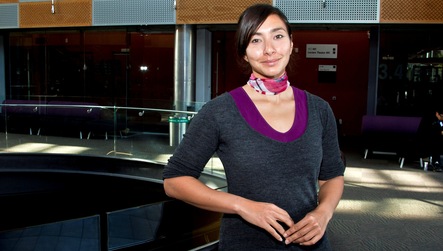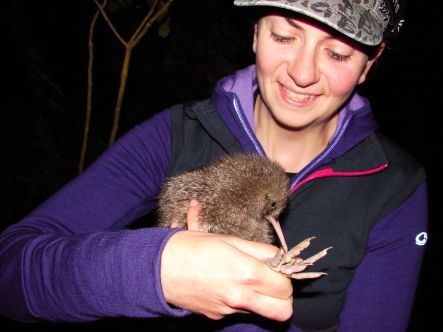Our Changing World for Thursday 24 January 2013
Maths, Queuing and Heart Patients
2013 is International Year of Mathematics, also known as the Mathematics of Planet Earth. To mark the year Our Changing World will be playing a number of maths-related stories during the year, and we kick off with a story about a statistician and heart patients.
 When Auckland City Hospital (left) was experiencing a cancellation rate for cardiac surgery that was approaching 30% the staff decided to ask a mathematician for help. University of Auckland statistician Ilze Ziedins is an expert in queuing theory and probability who often works in areas such as telecommunications and traffic, and she jumped at the chance to collaborate on a problem that involved people. Ilze and two of her graduate students, William Chen and Kim Frew, set out to develop a mathematical model of the Cardiavascular Intensive Care Unit using R, a statistical environment and programming language initially developed at the Ujiversity of Auckland by Ross Ihaka, and Robert Gentleman. The model took real-life data, and investigated different staffing and resourcing scenarios, and as a result was able to confirm what hospital staff had suspected – that the Cardiac Intensive Care Unit was the bottleneck that was creating problems. The model was also able to suggest an optimal staffing regime that took into account the irregular arrival of people in the unit, either from the operating theatre or as the result of an emergency. As a result ICU director Andrew Kee and other team members were able to allocate more staff and reduce the cancellation rate to about 10%.
When Auckland City Hospital (left) was experiencing a cancellation rate for cardiac surgery that was approaching 30% the staff decided to ask a mathematician for help. University of Auckland statistician Ilze Ziedins is an expert in queuing theory and probability who often works in areas such as telecommunications and traffic, and she jumped at the chance to collaborate on a problem that involved people. Ilze and two of her graduate students, William Chen and Kim Frew, set out to develop a mathematical model of the Cardiavascular Intensive Care Unit using R, a statistical environment and programming language initially developed at the Ujiversity of Auckland by Ross Ihaka, and Robert Gentleman. The model took real-life data, and investigated different staffing and resourcing scenarios, and as a result was able to confirm what hospital staff had suspected – that the Cardiac Intensive Care Unit was the bottleneck that was creating problems. The model was also able to suggest an optimal staffing regime that took into account the irregular arrival of people in the unit, either from the operating theatre or as the result of an emergency. As a result ICU director Andrew Kee and other team members were able to allocate more staff and reduce the cancellation rate to about 10%.
Alison Ballance heads to Auckland City Hospital to meet Ilze Ziedins and Cardiovascular Services Manager Pam Freeman, and find out more about the collaboration.
Nanoindentation

At the University of Auckland, Michelle Dickinson (above) runs the Nano-Mechanical Research laboratory where diamonds are being used to indent samples at the nano-scale, to test the mechanical properties of a whole range of materials from biological cells to miniatuarised devices.
Since the 1800s, the relative hardness of materials has been measured using a simple scratch test. With advances in technology, these indentation tests can be done on very tiny objects. The diamond tips used in indentation tests are different shapes and sizes depending on the samples being tested and how much pressure is applied. For example, the strength of bone can be tested to see how healthy it is and determine the effects of osteoporosis, and mineralised sea creatures such as sea urchins can be tested to see how they are impacted by ocean acidification. The diamond tips that are used can also be specially designed so they can test biological materials in fluid, for example, brain cells.
Ruth Beran visits the Nano-Mechanical Research laboratory to see some nanoindentation.
Managing Our Oceans
New Zealand lays claim to an area of ocean more than 20 times its landmass, the fourth largest Exclusive Economic Zone of any nation. Ninety-six per cent of New Zealand territory is under water and the management of our marine resources and habitats is a balancing act between use and protection.
Earlier this month, Te Papa hosted the first in a series of Getting Down to Earth debates, which focused on the Kermadec Islands and our role as kaitiaki or guardians of the oceans around us. Three leading thinkers shared their future vision and discussed what they see as the biggest issues in the managament of marine resources and habitats. You'll hear from risk management consultant Mike Patrick, writer and photographer Kennedy Warne and Bronwen Golder, who leads the campaign to protect the seas around the Kermadec Islands.
Full length - Managing our Oceans debate
A debate held at Te Papa about New Zealanders' role as kaitiaki of our oceans, featuring risk management consultant Mike Patrick, writer and photographer Kennedy Warne and Bronwen Golder, who leads the campaign to protect the seas around the Kermadec Islands.
Little Spotted Kiwi and Genetic Diversity

Helen Taylor holds a little spotted kiwi chick - just a few days old the chick is already foraging on its own at night (image: J. Briggs)
Little spotted kiwi are the smallest of the five kiwi species, and today’s population of 1700-or-so birds are all descended from just five individuals that were translocated to Kapiti Island in the early twentieth century. PhD student Helen Taylor from Victoria University is looking at the effect of this genetic bottleneck on the breeding success of little spotted kiwi, and Alison Ballance joins her for a night-time expedition in the Zealandia sanctuary in central Wellington to collect information from a newly-hatched chick. Helen has a keen team of volunteers helping her, and on this evening she is joined by Bronwen Shepherd and Judy Briggs.
Helen is comparing the genetics and breeding success of birds at Zealandia, which are descended from 40 birds translocated from Kapiti Island, to the population on Long Island in the Marlborough Sounds which is descended from just two birds.
Chick-timer transmitters on the male birds, which incubate the eggs, alert the researchers as to when incubation and hatching have happened – you can listen to Helen explaining the transmitters to Simon Morton in this story from This Way Up.
Andrew Digby from Victoria University has recently completed his PhD on the calls of little spotted kiwi – you can listen to that Our Changing World story here.